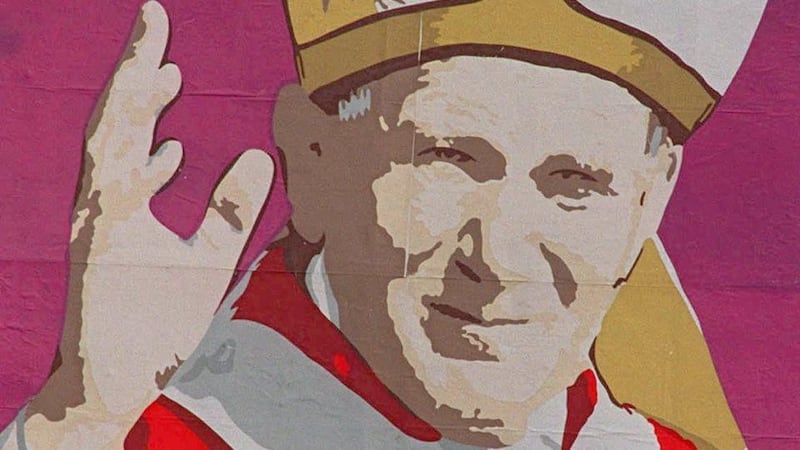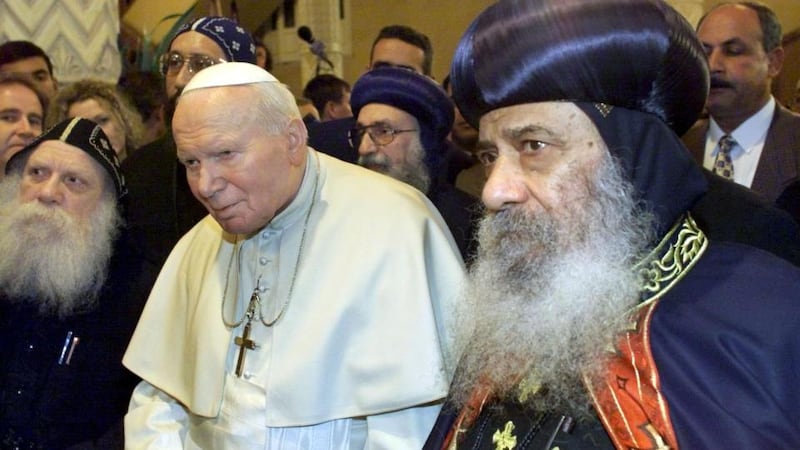We were in a monastery garden at the foot of Mount Sinai, but it might as well have been the parish church in Ballydehob. Pope John Paul II was saying Mass to a couple of hundred people as children wailed and loud conversation continued at the back.
This was in 2000, at the Holy Monastery of St Catherine, in Egypt, sited where, by tradition, God is said to have spoken to Moses from a burning bush. And Pope John Paul was transported, oblivious.
As petals from a blossoming tree showered on him, as if to order, he spoke of Sinai as “a soaring monument to what God revealed here.” A God “who is at once close at hand and far away . . . in the world but not of it . . . the name which is no name . . . the divine abyss in which essence and existence are one . . . the God who is being itself.”


It was impossible to avoid being moved by the pope, frail and wilting under the blossoms, who seemed possessed of some sort of spiritual ecstacy.
Travelling with him in those later years, long after his energetic 1979 visit to Ireland, was to witness the often excruciating struggle between his ailing, weary flesh as it fought endlessly with an indomitable spirit. It was a struggle that would continue to the death. It too was part of his armoury.
Two years earlier, in Santiago de Cuba, while we media burned red, doing our best to huddle in the slight shadow of a single bare tree, he visibly wilted as he said Mass. The huge congregation responded anxiously to his obvious suffering. That emotion came to a head at the shrine of St Lazarus in Havana the following night.
As he went among the sick and the infirm to bless them, many of those he touched seemed in far, far better shape than he, with his stick, his slow walk, his laboured speech, his tired, tired face and an almost completely closed eye. Watching him from the choir as he shuffled through the sick, two young girls began to cry.
Before that visit in 1998, the first of a pope to Cuba, it had been billed as an encounter between "the two last great autocrats of the 20th century", himself and Fidel Castro. They got on famously, with Castro even letting it be known how much he owed the ethic instilled in him by his Jesuit educators.
The pope’s visit there also precipitated the biggest invasion of Cuba by Americans since the Bay of Pigs. It was the background, too, for the fastest evacuation of Americans, when news broke of Monica Lewinsky’s tapes and TV companies called back their heavy guns.
Not all Cubans welcomed the visit. Ray and Lenin, for instance. (“Yes, that’s my name,” Lenin said, with a weary shake of his head). On a potholed side street they were selling cigars on the black market. The pope’s visit was interfering. “There are two million people in Havana, and this week there are one million police,” said an unhappy Ray.
When Pope John Paul arrived in Cairo in February 2000 everyone was there to greet him except the head of the Coptic Church, Pope Shenouda III, highlighting one of the oldest schisms in Christendom, centred on the primacy of the papacy. It was also sweet revenge. When Pope Shenouda visited Rome in 1973 Pope Paul VI did not greet him at the airport.
Pope John Paul later visited his Coptic counterpart in Cairo, as I am reminded every time I call to my mother. A photograph of the two popes walking side by side was published on the front page of this newspaper – and there am I in the background. (It’s also at the bottom of this page.) A colleague emailed me with his proposed caption: “The Pope from Rome. The Pope from Cairo, and the one from Ballaghaderreen.” My mother has the photograph in her hallway. The incongruity appeals to her.
But nothing the pope did on any visit can compare to his appearance at the Western, or Wailing, Wall, in Jerusalem in 2000. His welcome to Israel was "formal, even stand-offish", I wrote at the time, adding that "this tired pope has a lot of work to do here."
But he did it.
In one of the most dramatic gestures ever made towards the Jewish people, he prayed at the Western Wall as would a Jew and, as is traditional with Jews, he placed his prayer in one of its crevices.
It read: “God of our fathers, you chose Abraham and his descendants to bring your Name to the Nations: we are deeply saddened by the behaviour of those who in the course of history have caused these children of yours to suffer, and asking your forgiveness we wish to commit ourselves to genuine brotherhood with the people of the Covenant.”
The prayer was taken to the city’s Yad Vashem Holocaust memorial hall, where it is on permanent display.
Being in Jerusalem that day was to witness a conversion in sentiment every bit as sudden and complete as happened to Paul on the road to Damascus. A cool, suspicious people tripped over themselves to express their gratitude and affection.
Then the Israeli prime minister, Ehud Barak – who noted that when his people "were led from all over Christian Europe to the crematoria and the gas chambers . . . the silence was not only from the heavens" – praised Pope John Paul personally.
“You have done more than anyone else to bring about the historic change in the attitude of the church towards the Jewish people, initiated by the good Pope John XXIII,” he said.
Almost the entire Israeli cabinet took part in the official departure ceremony from Ben Gurion Airport.
Most had been absent for the arrival.








